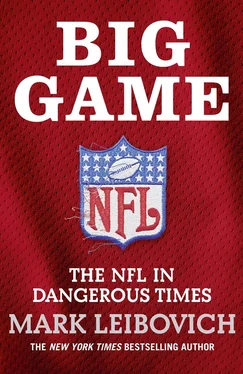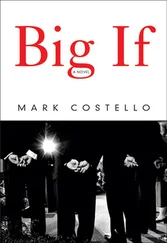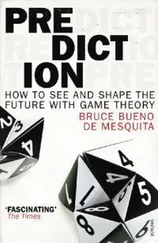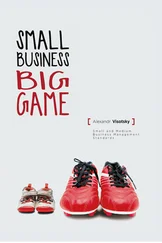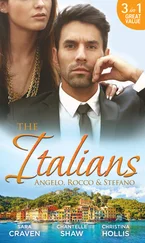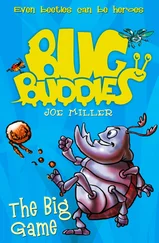Goodell bear-hugged draftees as they walked onstage. Every few picks, the commissioner would bring human shields with him up to the podium, maybe in an effort to discourage booing: these were the Make-A-Wish Foundation kids, elderly Hall of Famers, and beloved former Eagles whom no one would possibly hate, even in Philly. Who could badger even Roger when he was accompanied by a cancer-
stricken fourteen-year-old Ravens fan who read the name of Baltimore’s first-round selection? In an upset, the mob behaved itself and gave the kid a nice moment. The outdoor draft in general played to upbeat reviews, even evoked the Big Game ambience of a fall Sunday at certain points.
“Especially when they played the national anthem, I caught chills,” John Ross, a University of Washington wide receiver who was chosen in the ninth spot by the Cincinnati Bengals, said later. “I thought we were going to strap it up and play.” On nights like this, the NFL’s iconic logo, or “Shield,” might as well be the American flag.
This being the twenty-first-century NFL, even these shiny scenes are destined to get shaded with something. The well-played draft followed an incomparable Super Bowl—with the Pats’ overcoming a 28–3 deficit to stun the Falcons—but it was all being interspersed with one buzzkill or another. If it’s Monday, we were learning that Dwight Clark, the great 49ers receiver, had been diagnosed with ALS, probably related to his career choice; Tuesday brings news that the Bears’ Hall of Fame running back Gale Sayers is suffering from dementia. I caught brief word about the Clark and Sayers diagnoses on the NFL Network, which then moved seamlessly into another mock draft. Former Patriots tight end Aaron Hernandez, who was serving a life sentence for a murder conviction, was found hanging from a bed sheet in his Massachusetts prison cell on April 19. He died, at twenty-seven, with what researchers would later describe as the most severe case of CTE they had ever seen in a person his age. Hernandez also died, at the very least, with a dark sense of timing: that was also the day the Patriots were scheduled to make their post–Super Bowl visit to the White House.
Politics always seemed to be intruding somehow. This was very much a product of Donald J. Trump, and his ability to swallow up as much attention as possible from this bizarre American moment he was leading
the nation through. Why should football be safe? Indeed, minutes after Super Bowl 51 ended members of the Patriots—a team Trump had very publicly adopted as his own—were being asked whether they would visit the White House, given the polarizing ways of the new president. Patriots tight end Martellus Bennett was the first to say no thanks, and a running tally would ensue over who else would demur. Six Patriot players said they would skip the traditional visit, and there were several additional blow-offs on game day. Brady himself came under heavy pressure to pass from his wife, his liberal Bay Area family, and assorted other anti-Trump friends (Brady had known Trump for years, judged a beauty pageant, and golfed with him a bunch of times). On the appointed day, Brady was a no-show, citing “personal family matters”—as in, his family, especially his wife, would have killed him if he had gone. Brady’s absence put the starstruck Trump in a foul mood. He did not mention Brady in his Rose Garden remarks and did not take a phone call from the quarterback that night. Sad!
I HAVE WRITTEN ABOUT AMERICAN POLITICS AND CAMPAIGNS for sixteen years. Politics in that time has become a rolling entertainment spectacle, and perhaps the only real-stakes reality show that Americans were following as closely as they were the NFL. Politics grew hotter, as football did, under the raw nihilism of today’s culture. And that was even before Donald Trump was running for anything.
Trump’s presidential campaign featured many of the conditions that the NFL had enjoyed for years. He generated news every day, not all flattering, but enough to make him inescapable. He was covered by a pack of political reporters who often treated campaigns like Big Games themselves (with “pre- and postgame” coverage of debates), as opposed to complicated issue slogs with real-life consequences. Trump was his own Big Game, seemingly the only one people and media were paying attention to. He elicited passion pro and con. He appealed to a white male confirmation bias and sense of siege present in many who love football.
Every fan at some point becomes convinced the league office, other teams, referees, and announcers have it in for their utopia. The system is rigged against us. Like most Patriots devotees, I started hating Goodell for his punishment of Brady over Deflategate, the football air pressure debacle that (as Stephen Colbert correctly noted) was the rare sports scandal about shrinking balls that does not involve steroids. Did being mad at the league stop me from shelling out hundreds of dollars a year for tickets, DirecTV, NFL Sunday Ticket, RedZone, and the tools of dependence the cartel keeps pushing my way? That’s funny.
As with any decent reality show, the NFL is juiced by controversy, in many cases of its own making. Deflategate provided a trivial diversion after the previous season’s nightmare of a reality show, the one featuring the star running back cold-cocking his fiancée in an Atlantic City elevator and then dragging her limp body into the casino. Goodell suspended Ray Rice for two games only to have—plot twist—the security video of Rice’s knockout turn up on TMZ. This led Goodell to make Rice’s suspension “indefinite” and to months of recriminations over how the league could not have known about the video as it had claimed. It also raised fundamental questions about whether the NFL cared about domestic violence and—even more—about whether Goodell should keep his job. Reality TV does love a deathwatch.
Still, notwithstanding the NFL’s year-round ability to be compelling, something was happening to this sport. Football felt less confident and more precarious, at least from the outside. I wanted to immerse myself to a point that exceeded my usual fan’s engagement, beyond the preapproved all-access “experience” shows that bring us inside locker rooms and huddles and sideline confabs. For as ubiquitous as the NFL has made itself, there still remained a great mystery about the league. I had become especially curious about the closed cabal of “insiders” who owned, operated, and performed in the circus. The Rice case laid bare how little I knew about this world in a way I had not appreciated. It exposed a level of vulnerability in something that appeared so invincible. One day, a new season was set to begin, fresh with the promise of new ratings records and revenue horizons; next, this supposedly “existential crisis” hits the sport with the suddenness of a left jab on an elevator.
“Everything can change so fast in our society, for me or anyone else,’’ Goodell told me in one of the sporadic conversations we had over the last few years. ‘‘Only the paranoid survive’’ is a favorite mantra of his, and a phrase you hear a lot around NFL headquarters. It’s tempting to dismiss this as just another of the corporate clichés preferred by Goodell, someone who preambles many of his sentences with “As I say around the office . . .”
But “only the paranoid survive,” a motto associated with Intel’s Andy Grove, struck me as a telling conceit for the modern NFL. While Grove’s assertion is meant as a call to vigilance and aggressiveness, the NFL’s application of the phrase seemed more in tune with defensiveness and raw nerves. This also became clear to me as soon as I began peeking behind the Shield.
Читать дальше
